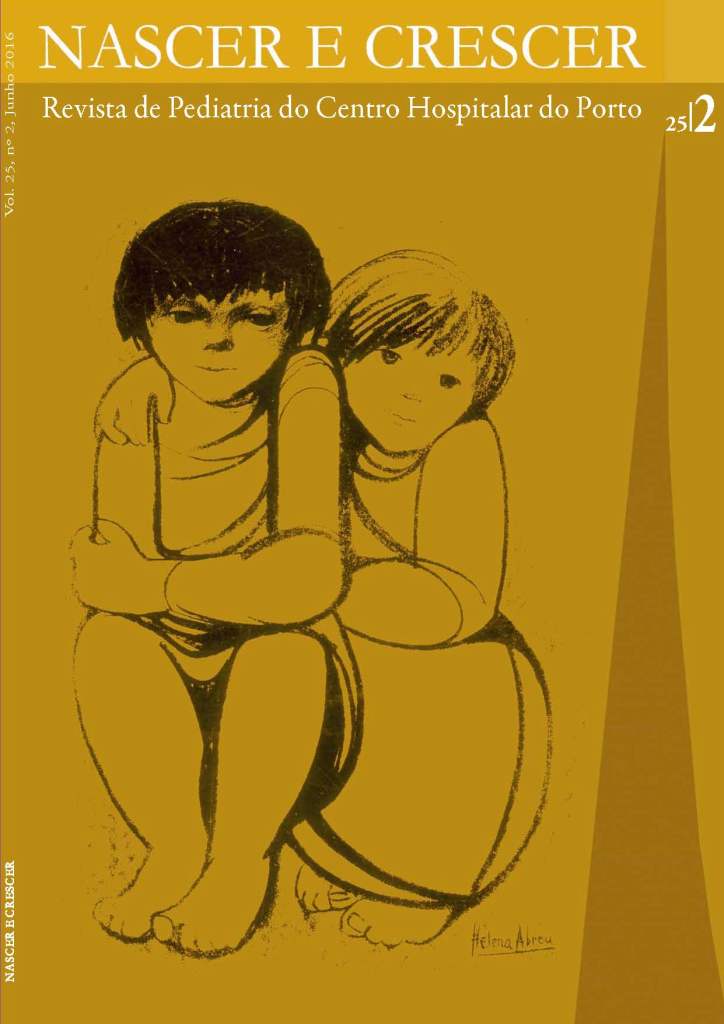POSITIVE BLOOD CULTURES FROM A PEDIATRIC DEPARTMENT: 2003-2012
DOI:
https://doi.org/10.25753/BirthGrowthMJ.v25.i2.9515Keywords:
antibiotic susceptibility, blood culture, pathogenic bacteria, pediatricAbstract
Introduction: In selected clinical situations is recommended to investigate the child with fever, including performing blood culture.
Aim: To analyze positive blood cultures for pathogenic bacteria in a pediatric department, including the most common agents, its evolution, respective antibiotic susceptibility and correlation with some clinical data.
Methods: Retrospective analysis of microbiological data of pathogens isolated in blood cultures and clinical data from children aged one month to 17 years, admitted in a pediatric department between 2003 and 2012.
Results: During the study period, the annual rate of positive blood cultures for potentially pathogenic bacteria ranged between 0.8% and 2.9%. In total, were isolated 158 pathogenic bacteria and the most common were: Staphylococcus aureus (29,1%), Streptococcus pneumoniae (27,8%), Escherichia coli (10,1%), Enterococcus faecalis (8,2%), Neisseria meningitidis (5,7%) and Streptococcus pyogenes (5,7%). No Neisseria meningitidis were resistant to ampicillin, 9% of Streptococcus pneumoniae had intermediate resistance to penicillin, 8,7% of Staphylococcus aureus were resistant to methicillin and 6,3% of Escherichia coli were resistant to amoxicillin/clavulanic acid. Sixty-seven percent of positive blood cultures for pathogenic bacteria corresponded to children under the age of 36 months. The most relevant diagnoses were: occult bacteremia, pneumonia, sepsis, meningitis and pyelonephritis. A child died due to septic shock (Streptococcus pneumoniae).
Conclusion: In the 10 years analyzed, the most common bacteria were: Staphylococcus aureus, Streptococcus pneumoniae and Escherichia coli. The incidence of Neisseria meningitidis after 2005 and Streptococcus pneumoniae after 2007 decreased. Susceptibility of different pathogenic bacteria to antimicrobials remained stable. We emphasize the importance of epidemiological and clinical monitoring of microbiological data.
Downloads
References
Leça A, Henriques C. Febre sem foco de infeção detetável. In: Videira Amaral JM, editor. “Tratado de Clínica Pediátrica – versão atualizada”. 2ªedição. Amadora: Abbott Laboratórios; 2013. p.1397-402.
Lee GM, Marvin BH. Risk of bacteriemia for febrile young children in the post-Haemophilus influenza type b era. Arch Pediatr Adolesc Med 1998;152: 624-8.
Baraff LJ. Management of Fever without source in infants and children. Ann Emerg Med 2000;36: 602-14.
Powell KR, Stormorken A. Sepsis and shock. In: Behrman RE, Kliegman RM, Arvin AM, editors. Nelson textbook of Pediatrics. 17th ed. Philadelphia: WB Saunders Company; 2003. p. 847-50.
Kaplan SL, Mason EO, Wald ER, Schutze GE, Bradley JS, Tan TQ, et al. Decrease of invasive pneumococcal infections in children among children’s hospitals in the United States after the introduction of the 7-valent pneumococcal conjugate vaccine. Pediatrics 2004;113: 443–9.
Herz AM, Greenhow TL, Alcantara J, Hansen J, Baxter RP, Black SB, et al. Changing epidemiology of outpatient bacteremia in 3- to 36-month-old children after the introduction of the heptavalent-conjugated pneumococcal vaccine. Pediatr Infect Dis J 2006;25: 293–300.
Alpern ER. Occult bacteremia from a Pediatric Emergency Department: current prevalence, time to detection, and outcome. Pediatrics 2000;106: 505–11.
Stoll ML, Rubin LG. Incidence of occult bacteraemia among highly febrile young children in the era of the pneumococcal conjugate vaccine. Arch Pediatr Adolesc Med 2004;158: 671-5.
Sard B, Bailey MC, Vinci R. An analysis of pediatric blood cultures in the postpneumococcal conjugate vaccine era in a community hospital emergency department. Pediatr Emerg Care 2006; 22: 295-300.
Fanjul JR. Positive blood cultures in a pediatric emergency department: a descriptive analysis. Emergencias 2012; 24:
-8.
Leonard P, Beattie TF. How do blood cultures sent from a paediatric accident and emergency department influence subsequent clinical management? Emerg Med J 2003;20: 347- 8.
Rodrigues F, Costa Alves M, Alves AF, Lemos L. Hemoculturas positivas num Serviço de Urgência Pediátrica: 1995-2005. Acta Pediatr Port 2007;38:69-72.
Leite F, Faria C. Hemoculturas positivas num Serviço de Urgência Pediátrica. RPDI 2010;6: 60-5.
Kloos WE, Bannerman TL. Staphylococcus and Micrococcus. In: Murray PR, Baron EJ, Pfaller MA, Tenover FC, Yolken RH, editors. Manual of Clinical Microbiology. 6th ed. Washington: ASM Press; 1995. p. 282-98.
Roth A, Wiklund AE, Palsson AS, Melander EZ, Wullt M, Cronqvist J, et al. Reducing blood culture contamination by a simple informational intervention. J Clin Microbiol 2010;48: 4552–8.
Hall KK, Lyman JA. Updated review of blood culture contamination. Clin Microbiol Rev 2006;19: 788–802.
Aguiar S, Brito MJ, Horácio NA, Lopes JP, Melo-Cristino J. Decreasing incidence and changes in serotype distribution of invasive pneumococcal disease in persons aged under 18 years since introduction of 10-valent and 13-valent conjugate vaccines in Portugal, July 2008 to June 2012. Euro Surveill 2014; 19(12).
Grupo de Estudo de Doença Pneumocócica da Sociedade de Infecciologia Pediátrica/Sociedade Portuguesa de Pediatria. Dados nacionais doença invasiva pneumocócica 2010–2012. Outubro, 2012. (Acedido em 3 de Novembro de 2015). Disponível em: http://www.spp.pt/UserFiles/file/Protocolos/Doenca_Invasiva_Pneumococica_2010_2012_2.pdf.
Das I, Gray J. Enterococcal bacteriemia in children: a review of seventy-five episodes in a pediatric hospital. Pediatr Infect Dis J 1998;17:1154-8.
Noskin GA, Peterson LR, Warren JR. Enterococcus faecium and Enterococcus faecalis bacteriemia: acquisition and outcome. Clin Infect Dis 1995;20: 296-301.
Downloads
Published
How to Cite
Issue
Section
License
Copyright and Authors' Rights
All articles published in Nascer e Crescer - Birth and Growth Medical Journal are Open Access and comply with the requirements of funding agencies or academic institutions. For use by third parties, Nascer e Crescer - Birth and Growth Medical Journal adheres to the terms of the Creative Commons License "Attribution - Non-Commercial Use (CC-BY-NC)".
It is the author's responsibility to obtain permission to reproduce figures, tables, etc. from other publications.
Authors must submit a Conflict of Interest statement and an Authorship Form with the submission of the article. An e-mail will be sent to the corresponding author confirming receipt of the manuscript.
Authors are permitted to make their articles available in repositories at their home institutions, provided that they always indicate where the articles were published and adhere to the terms of the Creative Commons license.


